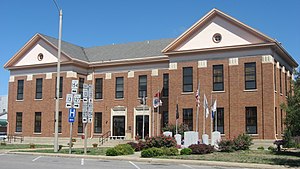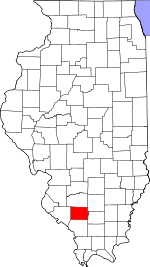Perry County, Illinois
Perry County | |
|---|---|
U.S. county | |
 Perry County Courthouse in Pinckneyville | |
 Location within the U.S. state of Illinois | |
 Illinois's location within the U.S. | |
| Coordinates: 38°05′N 89°22′W / 38.09°N 89.37°W | |
| Country | |
| State | |
| Founded | 29 January 1827 |
| Named for | Oliver Hazard Perry |
| Seat | Pinckneyville |
| Largest city | Du Quoin |
| Area | |
| • Total | 447 sq mi (1,160 km2) |
| • Land | 442 sq mi (1,140 km2) |
| • Water | 5.2 sq mi (13 km2) 1.2% |
| Population (2010) | |
| • Total | 22,350 |
| • Estimate (2018) | 21,174 |
| • Density | 50/sq mi (19/km2) |
| Time zone | UTC−6 (Central) |
| • Summer (DST) | UTC−5 (CDT) |
| Congressional district | 12th |
| Website | perryil |
Perry County is in Illinois. According to the 2010 census, it had a population of 22,350.[1] Its county seat is Pinckneyville.[2] It is located in the southern portion of Illinois known as "Little Egypt".
History[]
Perry County was formed in 1827 out of Jackson and Randolph counties. It was named in honor of Oliver Hazard Perry who defeated the British fleet at the decisive Battle of Lake Erie in the War of 1812.

Perry County at the time of its creation in 1827
In its early history, Perry County was mainly an inland pioneer outpost. Early settlers, including some Revolutionary War veterans bearing land grants, moved here from the Eastern United States. These were primarily Protestant settlers. Growth boomed in the 1850s for two reasons: construction of the Illinois Central Railroad through the eastern portion of the county, and the discovery of large coal reserves. Immigrants from Ireland, Poland, Germany, Italy and elsewhere steadily increased the County's population from 1850 through the 1920s. African Americans also were established in the County during northward migration following the Civil War.
Mining continued to be the dominant employment sector through the 1990s.
Geography[]
According to the U.S. Census Bureau, the county has a total area of 447 square miles (1,160 km2), of which 442 square miles (1,140 km2) is land and 5.2 square miles (13 km2) (1.2%) is water.[3]
Perry County is located in Southern Illinois. Pinckneyville, at the center of the county, is approximately 70 miles (110 km) southeast of St. Louis, Missouri and 300 miles (480 km) southwest of Chicago. The Mississippi River lies about 10 miles (16 km) west and southwest of the County at its closest point.
The County's topography is mainly flat with some rolling hills. The part of the County's eastern border, the part shared with Franklin County, is formed by the Little Muddy River. Beaucoup Creek runs north to south through the County and lies just east of Pinckneyville.
The county's topography also features many "strip cut" lakes, lakes left behind following above-ground coal mining. Lakes at two of the county's chief recreation areas, the Du Quoin State Fairgrounds and Pyramid State Recreation Area, were formed this way.
Climate and weather[]
| Pinckneyville, Illinois | ||||||||||||||||||||||||||||||||||||||||||||||||||||||||||||
|---|---|---|---|---|---|---|---|---|---|---|---|---|---|---|---|---|---|---|---|---|---|---|---|---|---|---|---|---|---|---|---|---|---|---|---|---|---|---|---|---|---|---|---|---|---|---|---|---|---|---|---|---|---|---|---|---|---|---|---|---|
| Climate chart (explanation) | ||||||||||||||||||||||||||||||||||||||||||||||||||||||||||||
| ||||||||||||||||||||||||||||||||||||||||||||||||||||||||||||
| ||||||||||||||||||||||||||||||||||||||||||||||||||||||||||||
In recent years, average temperatures in the county seat of Pinckneyville have ranged from a low of 22 °F (−6 °C) in January to a high of 90 °F (32 °C) in July, although a record low of −22 °F (−30 °C) was recorded in January 1912 and a record high of 113 °F (45 °C) was recorded in July 1934. Average monthly precipitation ranged from 2.61 inches (66 mm) in February to 4.81 inches (122 mm) in May.[4]
Major highways[]
 U.S. Route 51
U.S. Route 51 Illinois Route 4
Illinois Route 4 Illinois Route 13
Illinois Route 13 Illinois Route 14
Illinois Route 14 Illinois Route 127
Illinois Route 127 Illinois Route 150
Illinois Route 150 Illinois Route 152
Illinois Route 152 Illinois Route 154
Illinois Route 154
Adjacent counties[]
- Washington County - north
- Jefferson County - northeast
- Franklin County - east
- Jackson County - south
- Randolph County - west
Demographics[]
| Historical population | |||
|---|---|---|---|
| Census | Pop. | %± | |
| 1830 | 1,215 | — | |
| 1840 | 3,222 | 165.2% | |
| 1850 | 5,278 | 63.8% | |
| 1860 | 9,552 | 81.0% | |
| 1870 | 13,723 | 43.7% | |
| 1880 | 16,007 | 16.6% | |
| 1890 | 17,529 | 9.5% | |
| 1900 | 19,830 | 13.1% | |
| 1910 | 22,088 | 11.4% | |
| 1920 | 22,901 | 3.7% | |
| 1930 | 22,767 | −0.6% | |
| 1940 | 23,438 | 2.9% | |
| 1950 | 21,684 | −7.5% | |
| 1960 | 19,184 | −11.5% | |
| 1970 | 19,757 | 3.0% | |
| 1980 | 21,714 | 9.9% | |
| 1990 | 21,412 | −1.4% | |
| 2000 | 23,094 | 7.9% | |
| 2010 | 22,350 | −3.2% | |
| 2018 (est.) | 21,174 | [5] | −5.3% |
| U.S. Decennial Census[6] 1790-1960[7] 1900-1990[8] 1990-2000[9] 2010-2013[1] | |||
As of the 2010 United States Census, there were 22,350 people, 8,335 households, and 5,622 families residing in the county.[10] The population density was 50.6 inhabitants per square mile (19.5/km2). There were 9,426 housing units at an average density of 21.3 per square mile (8.2/km2).[3] The racial makeup of the county was 87.9% white, 8.3% black or African American, 0.4% Asian, 0.2% American Indian, 1.6% from other races, and 1.4% from two or more races. Those of Hispanic or Latino origin made up 2.7% of the population.[10] In terms of ancestry, 32.8% were German, 14.3% were Irish, 10.6% were English, 8.1% were American, and 6.3% were Polish.[11]
Of the 8,335 households, 30.4% had children under the age of 18 living with them, 51.5% were married couples living together, 11.3% had a female householder with no husband present, 32.5% were non-families, and 28.6% of all households were made up of individuals. The average household size was 2.38 and the average family size was 2.90. The median age was 39.4 years.[10]
The median income for a household in the county was $40,696 and the median income for a family was $50,130. Males had a median income of $40,768 versus $28,377 for females. The per capita income for the county was $17,926. About 11.5% of families and 14.0% of the population were below the poverty line, including 22.6% of those under age 18 and 6.9% of those age 65 or over.[12]
Communities[]
Perry County never adopted a township form of government. Federal township plats were prepared for each township which include legal descriptions of 14 townships.[13]
Perry County has been divided into precincts: Beaucoup, Cutler, Denmark, DuQuoin, Paradise, Pinckneyville, Sunfield, Swanwick, Tamaroa and Willisville.[14] To provide election precincts of similar population based on recent census data, precincts are divided or combined to form election precincts. The election precincts in 2020 were: Beaucoup, Cutler, Du Quoin Number 1, Du Quoin Number 2, Du Quoin Number 3, Du Quoin Number 4, Du Quoin Number 5, Du Quoin Number 6, Du Quoin Number 7, Du Quoin Number 8, Du Quoin Number 9, Du Quoin Number 10, Du Quoin Number 11, Du Quoin Number 12, Pinckneyville Number 1, Pinckneyville Number 2, Pinckneyville Number 3, Pinckneyville Number 4, Pinckneyville Number 5, Pinckneyville Number 6, Pinckneyville Number 7, Pinckneyville Number 8, Sunfield, Swanwick, Tamaroa Number 1, Tamaroa Number 2, and Willisville.[15]
Cities[]
Villages[]
Unincorporated communities[]
Politics[]
Perry County has been a rock-ribbed Republican county since 2012, when it backed Mitt Romney (R) by nearly 18 points over Illinois native Barack Obama, even as Obama won both Illinois and the country. By 2020 it was so heavily Republican that Donald Trump trounced Democrat Joe Biden by nearly 45 points in his bid for reelection, even as Biden won the race nationally (and Illinois). The county last voted blue, by a very narrow margin of 0.6%, in 2000. The table below includes a list of Perry County's election results at the presidential level.
See also[]
- National Register of Historic Places listings in Perry County
References[]
- ^ Jump up to: a b "State & County QuickFacts". United States Census Bureau. Archived from the original on June 7, 2011. Retrieved July 8, 2014.
- ^ "Find a County". National Association of Counties. Retrieved June 7, 2011.
- ^ Jump up to: a b "Population, Housing Units, Area, and Density: 2010 - County". United States Census Bureau. Archived from the original on February 13, 2020. Retrieved July 12, 2015.
- ^ Jump up to: a b "Monthly Averages for Pinckneyville, Illinois". The Weather Channel. Retrieved January 27, 2011.
- ^ "Population and Housing Unit Estimates". Retrieved November 3, 2019.
- ^ "U.S. Decennial Census". United States Census Bureau. Retrieved July 8, 2014.
- ^ "Historical Census Browser". University of Virginia Library. Retrieved July 8, 2014.
- ^ "Population of Counties by Decennial Census: 1900 to 1990". United States Census Bureau. Retrieved July 8, 2014.
- ^ "Census 2000 PHC-T-4. Ranking Tables for Counties: 1990 and 2000" (PDF). United States Census Bureau. Retrieved July 8, 2014.
- ^ Jump up to: a b c "DP-1 Profile of General Population and Housing Characteristics: 2010 Demographic Profile Data". United States Census Bureau. Archived from the original on February 13, 2020. Retrieved July 12, 2015.
- ^ "DP02 SELECTED SOCIAL CHARACTERISTICS IN THE UNITED STATES – 2006-2010 American Community Survey 5-Year Estimates". United States Census Bureau. Archived from the original on February 13, 2020. Retrieved July 12, 2015.
- ^ "DP03 SELECTED ECONOMIC CHARACTERISTICS – 2006-2010 American Community Survey 5-Year Estimates". United States Census Bureau. Archived from the original on February 13, 2020. Retrieved July 12, 2015.
- ^ T4S_R1W_3PM (1). Perry County Township Plats. U.S. Surveyor General's Records for Illinois: Federal Township Plats. Illinois State Archives. Accessed 25 July 2021.
- ^ Perry County, IL History. Accessed Jul 2021.
- ^ Illinois Gazeteer: Perry County. Hometown Locator. Accessed July 2021.
- ^ Leip, David. "Dave Leip's Atlas of U.S. Presidential Elections". uselectionatlas.org. Retrieved November 11, 2018.
- Illinois counties
- Perry County, Illinois
- Southern Illinois
- 1827 establishments in Illinois
- Populated places established in 1827



